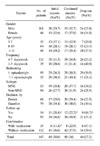Abstract
Purpose
Alarm interventions are effective and safe treatments for nocturnal enuresis when compared with the other treatments. However, the rate of doctors prescribing enuresis alarms is quite low in Korea. This study evaluated the application conditions and treatment results of an enuresis alarm in children with enuresis in Korea.
Materials and Methods
147 out of 316 patients who purchased an enuresis alarm through a alarm sales agency in Korea were evaluated retrospectively. The questionnaire had two main categories: items of enuresis (number of episodes during the night, enuresis frequency during a week, etc.) and the items of the enuresis alarm (previous treatment history, a motivation of using enuresis alarm treatment, the period of using the enuresis alarm, initial success, continued success, dropout of using enuresis alarm, nocturia after treatment, etc.).
Results
A total 147 children participated in this study. The initial success rate was 30.6% whereas the continued success rate was 34.0%. In addition, the dropout rate was 27.2%. 46.2% of patients purchased the enuresis alarm with a doctor's prescription and 53.8% purchased the alarm without a prescription. Among the factors, the success and dropout rate were affected by only whether the patient visited the hospital. Thirty five patients who took combination therapy with medicine had a significantly lower initial success rate.
Figures and Tables
Fig. 1
The reason why the guardian purchased an enuresis alarm. NR: no response, R: recurrence, S/E: side effect.

References
1. Butler RJ. Establishment of working definitions in nocturnal enuresis. Arch Dis Child. 1991. 66:267–271.
2. Novello AC, Novello JR. Enuresis. Pediatr Clin North Am. 1987. 34:719–733.
3. Fitzwater D, Macknin ML. Risk/benefit ratio in enuresis therapy. Clin Pediatr (Phila). 1992. 5:308–310.
4. Husmann DA. Enuresis. Urology. 1996. 48:184–193.
5. Alon US. Nocturnal enuresis. Pediatr Nephrol. 1995. 9:94–103.
6. Butler RJ. Annotation: night wetting in children: psychological aspects. J Child Psychol Psychiatry. 1998. 39:453–463.
7. Morison MJ. Parents' and young people's attitudes towards bedwetting and their influence on behaviour, including readiness to engage in and persist with treatment. Br J Urol. 1998. 81:Suppl 3. 56–66.
8. van Tijen NM, Messer AP, Namdar Z. Perceived stress of nocturnal enuresis in childhood. Br J Urol. 1998. 81:Suppl 3. 98–99.
9. Moffatt ME, Harlos S, Kirshen AJ, Burd L. Desmopressin acetate and nocturnal enuresis: how much do we know? Pediatrics. 1993. 92:420–425.
10. Evans JH, Meadow SR. Desmopressin for bed wetting: length of treatment, vasopressin secretion, and response. Arch Dis Child. 1992. 67:184–188.
11. Ye JW, Lee SD. The comparison of therapeutic effect between imipramine and desmopressin on enuretic patients. Korean J Urol. 2001. 42:75–79.
12. Wille S. Comparison of desmopressin and enuresis alarm for nocturnal enuresis. Arch Dis Child. 1986. 61:30–33.
13. Kim WB, Kim KD. The epidemiology of childhood enuresis in Seoul and Kyunggi province. Korean J Urol. 1998. 39:1166–1170.
14. Jensen N, Kristensen G. Frequency of nightly wetting and the efficiency of alarm treatment of nocturnal enuresis. Scand J Urol Nephrol. 2001. 35:357–363.
15. Cho SC, Kim JW, Shin MS, Hwang JW, Han SW, Park KH, et al. Behavioral and emotional problems in children with nocturnal enuresis: results of a multicenter study. J Korean Neuropsychiatr Assoc. 2005. 44:730–735.
16. Young CG. Conditioning treatment of enuresis. Dev Med Child Neurol. 1965. 7:557–562.
17. Stephen AK, Venkata RJ. Walsh PC, Retik AB, Vaughan ED, Wein J, editors. Non-neurogenic lower urinary tract dysfuction. Campbell's urology. 2002. 8th ed. Philadelphia: Saunders;2273–2280. .
18. Monda JM, Husmann DA. Primary nocturnal enuresis: a comparison among observation, imipramine, desmopressin acetate and bed-wetting alarm systems. J Urol. 1995. 154:745–748.
19. Dische S. Management of enuresis. Br Med J. 1971. 2:33–36.
20. Devlin JB, O'Cathain C. Predicting treatment outcome in nocturnal enuresis. Arch Dis Child. 1990. 65:1158–1161.
21. Meadow R. How to use buzzer alarms to cure bed-wetting. Br Med J. 1977. 2:1073–1075.
22. Oh W, Park KH. Additional treatment of enuresis alarm for partial responders to oral desmopressin in enuretic children. Korean J Urol. 2003. 44:227–232.
23. Jang I, Min SJ, Kang MR, Kim DK, Woo SH. A combination of enuresis alarm-desmopressin as a first line in monosymptomatic nocturnal enuresis. Korean J Urol. 2005. 46:19–24.
24. Hjalmas K, Arnold T, Bower W, Caione P, Chiozza LM, von Gontard A, et al. Nocturnal enuresis: an international evidence based management strategy. J Urol. 2004. 171:2545–2561.




 PDF
PDF ePub
ePub Citation
Citation Print
Print




 XML Download
XML Download